Ginger and Turmeric a High Value Crop for Local Growers
go.ncsu.edu/readext?829383
en Español / em Português
El inglés es el idioma de control de esta página. En la medida en que haya algún conflicto entre la traducción al inglés y la traducción, el inglés prevalece.
Al hacer clic en el enlace de traducción se activa un servicio de traducción gratuito para convertir la página al español. Al igual que con cualquier traducción por Internet, la conversión no es sensible al contexto y puede que no traduzca el texto en su significado original. NC State Extension no garantiza la exactitud del texto traducido. Por favor, tenga en cuenta que algunas aplicaciones y/o servicios pueden no funcionar como se espera cuando se traducen.
Português
Inglês é o idioma de controle desta página. Na medida que haja algum conflito entre o texto original em Inglês e a tradução, o Inglês prevalece.
Ao clicar no link de tradução, um serviço gratuito de tradução será ativado para converter a página para o Português. Como em qualquer tradução pela internet, a conversão não é sensivel ao contexto e pode não ocorrer a tradução para o significado orginal. O serviço de Extensão da Carolina do Norte (NC State Extension) não garante a exatidão do texto traduzido. Por favor, observe que algumas funções ou serviços podem não funcionar como esperado após a tradução.
English
English is the controlling language of this page. To the extent there is any conflict between the English text and the translation, English controls.
Clicking on the translation link activates a free translation service to convert the page to Spanish. As with any Internet translation, the conversion is not context-sensitive and may not translate the text to its original meaning. NC State Extension does not guarantee the accuracy of the translated text. Please note that some applications and/or services may not function as expected when translated.
Collapse ▲In January 2011 I was at a Southern SAWG Sustainable Agriculture Conference in Chattanooga, TN when I spotted Maine grower Susan Anderson’s East Branch Ginger booth at the trade show. Susan was selling certified organic disease-free ginger seed stock. I was intrigued because I knew a couple of forward-thinking farmers were experimentally growing ginger in North Carolina but very little was known about it. So I hung around Susan’s booth during her presentations until the crowds had cleared away and then introduced myself. I told her I was an Agriculture Agent with N.C. Cooperative Extension and asked her if she would be willing to do a presentation on growing ginger at a Cooperative Extension workshop in Chatham County, North Carolina. She said yes! Long story short…a mere two months later we did our first Ginger Production Workshop in Chatham County, she and her husband and two kids ended up moving to Chatham County that May and we went on to do two more workshops in 2012 on growing ginger and turmeric. In all, about 250 growers from across the state attended these workshops. East Branch Ginger has now transitioned to producing microgreens and edible flowers and Susan and I have become good friends. And many growers are now growing these specialty crops across the state!
I was recently out at Granite Springs Farm in Pittsboro while grower Meredith Leight was harvesting ginger and turmeric. Meredith attended our ginger and turmeric workshops in 2011 and 2012 and has grown these crops every year since! She tells me they are the most high value crops she produces. She sells ginger and turmeric at the Pittsboro Farmers’ Market, to local restaurants, through her Community Supported Agriculture (CSA) program, and to Farmer Foodshare. Local brewers have made tasty beer from Meredith’s ginger. Ginger and turmeric are available on-line from the Granite Springs Farm on-line store.
For folks close to Pittsboro, you can also pre-order ginger and turmeric for pick-up at the weekly Pittsboro Farmers’ Market on Thursdays from 3-6 p.m. Order on-line from the farm store before midnight each Wednesday for Thursday pick-up (the on-line store opens up again on Thursday evening).
Chefs, beer and kombucha brewers, and others wanting five pounds or more can visit the Granite Springs Farm website to learn about wholesale opportunities.
Meredith raises her ginger and turmeric in high tunnels. Seed stock arrives in February and is pre-sprouted in flats of coco coir in a germination chamber that maintains high temperatures and high humidity. After about a month of pre-sprouting, the seed pieces are planted in the ground in March (some growers plant into plastic grow bags) once soil temperatures are consistently above 50° F and actively warming. Ginger is a heavy feeder and gets hilled and fertilized about three times during the growing season. Hilling ensures the rhizomes stay covered during growth and increases yield. Baby ginger is harvested about six months after planting while turmeric takes about seven months. NC growers produce baby ginger which is tender with robust flavor and not fibrous like mature ginger.
Ginger has many uses: it can be used frozen, dried, or used fresh for cooking; pickled, candied, juiced, made into tea, and taken medicinally. Turmeric is also used extensively in cooking and it also has many medicinal uses.
I took the photos below in late October at Granite Springs Farm during a harvest day.
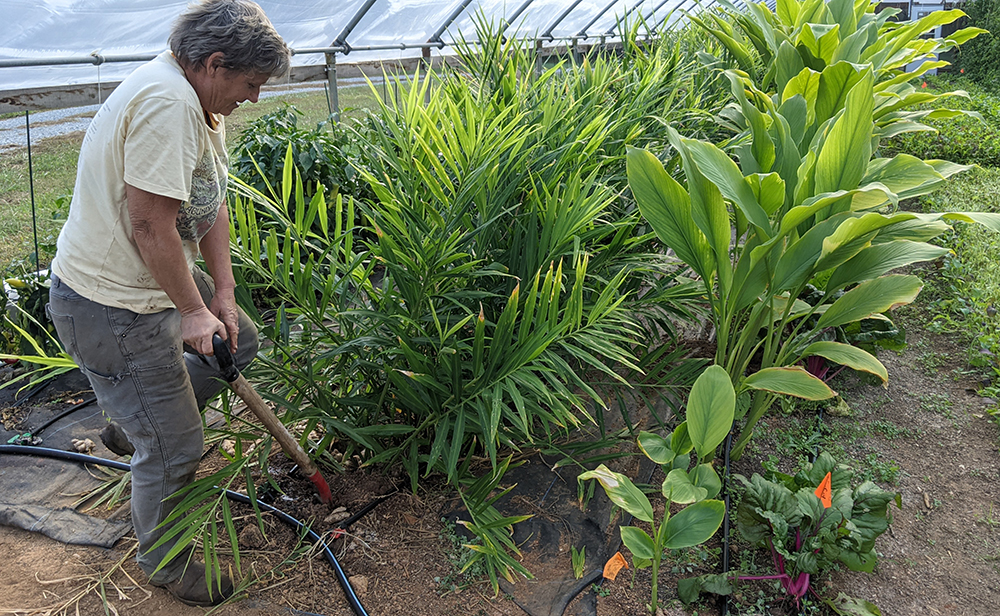
Meredith uses a digging fork to harvest a ginger plant in one of the high tunnels. The ginger seed stock is acquired in February and it goes through a one month pre-sprout process before planting. Meredith built a germination chamber inside her farm kitchen that maintains the seed stock at around 80 degrees with high humidity for about a month to pre-sprout. Photo by Debbie Roos.

The fork loosens the soil so the ginger rhizomes can be easily harvested. Meredith plants the ginger in March (after pre-sprouting) so it takes about six months before the rhizomes are ready to harvest. Rhizome growth increase later in the season as day length decreases. Photo by Debbie Roos.
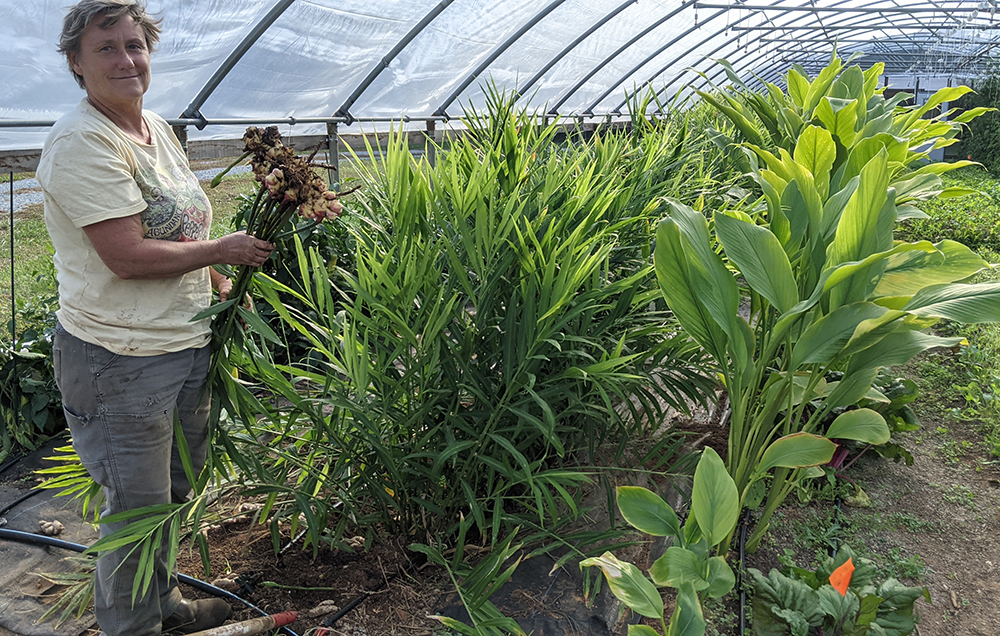
Freshly harvested ginger root! Meredith will be able to harvest ginger for a 3-4 week period. Growers are harvesting tender baby ginger…it’s not fibrous like the mature ginger root you find in grocery stores and doesn’t need peeling. Photo by Debbie Roos.

Now it’s time to harvest some turmeric! Like ginger, the turmeric also goes through a pre-sprouting process. Photo by Debbie Roos.
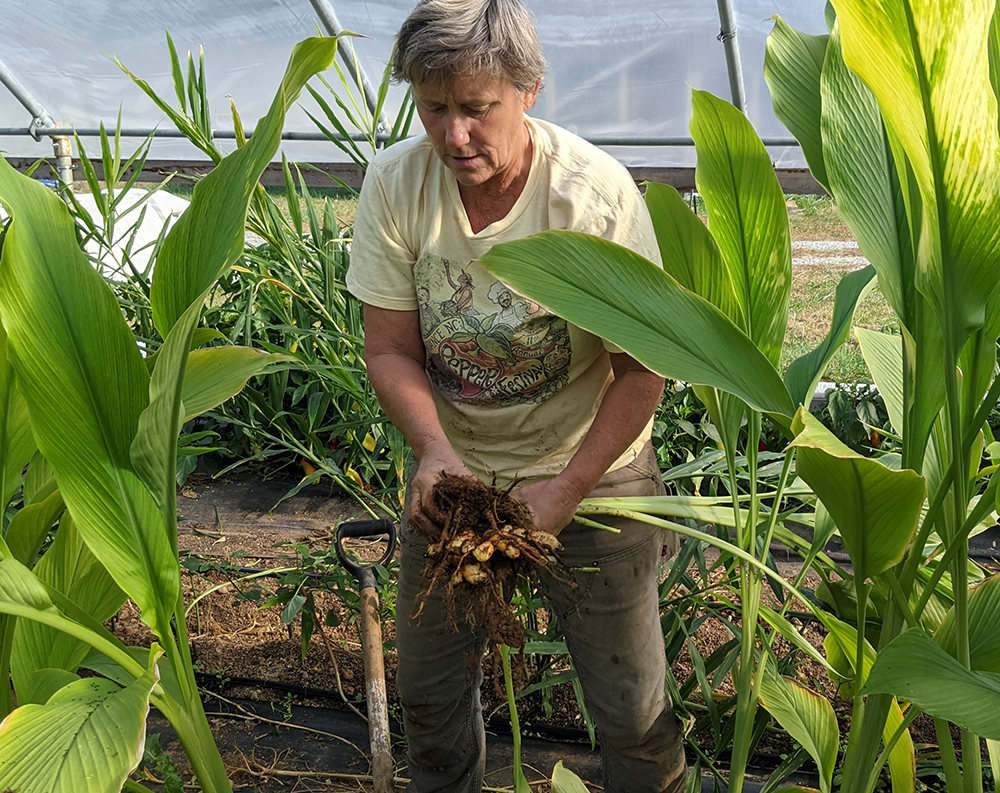
Meredith removes soil from the turmeric rhizomes. Turmeric takes a little longer to grow than ginger; harvest typically begins about seven months after planting. Photo by Debbie Roos.

Freshly harvested turmeric! This variety is called ‘Indira Yellow’. Photo by Debbie Roos.
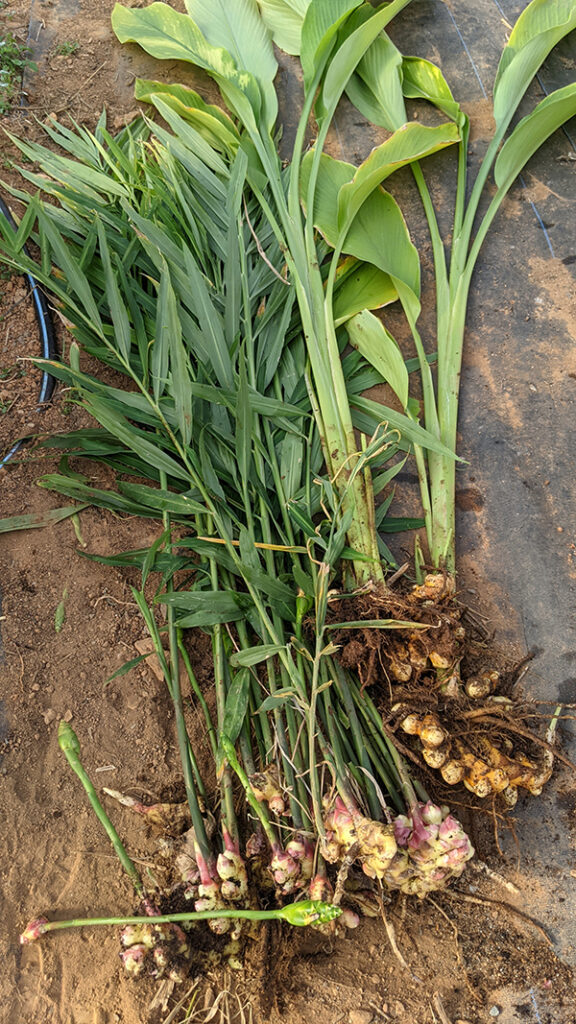
Freshly harvested ginger (left) and turmeric. The tops are removed after harvest and can be dried and made into tea. Turmeric leaves can be used in curries and soups and can be pickled. Turmeric leaves can be used as a wrapper for steamed dishes. Photo by Debbie Roos.
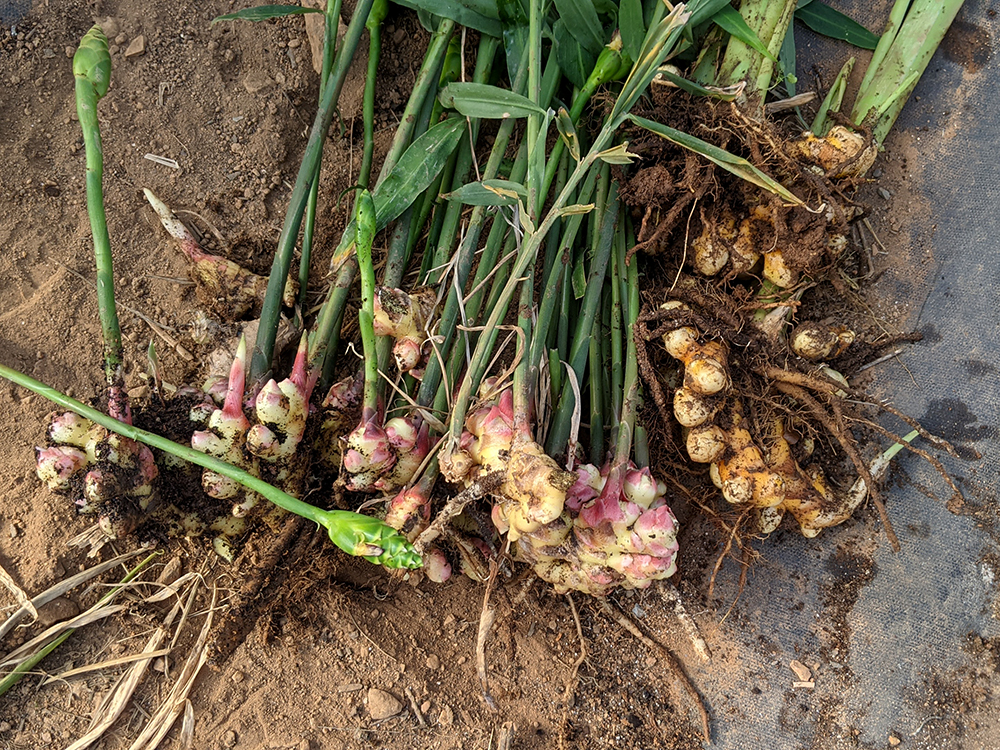
Freshly harvested ginger (left) and turmeric. Photo by Debbie Roos.

Meredith washes ginger in the packing shed. She built a hands-free foot-operated washing station! Photo by Debbie Roos.

The ginger and turmeric are washed and trimmed after harvest. Photo by Debbie Roos.
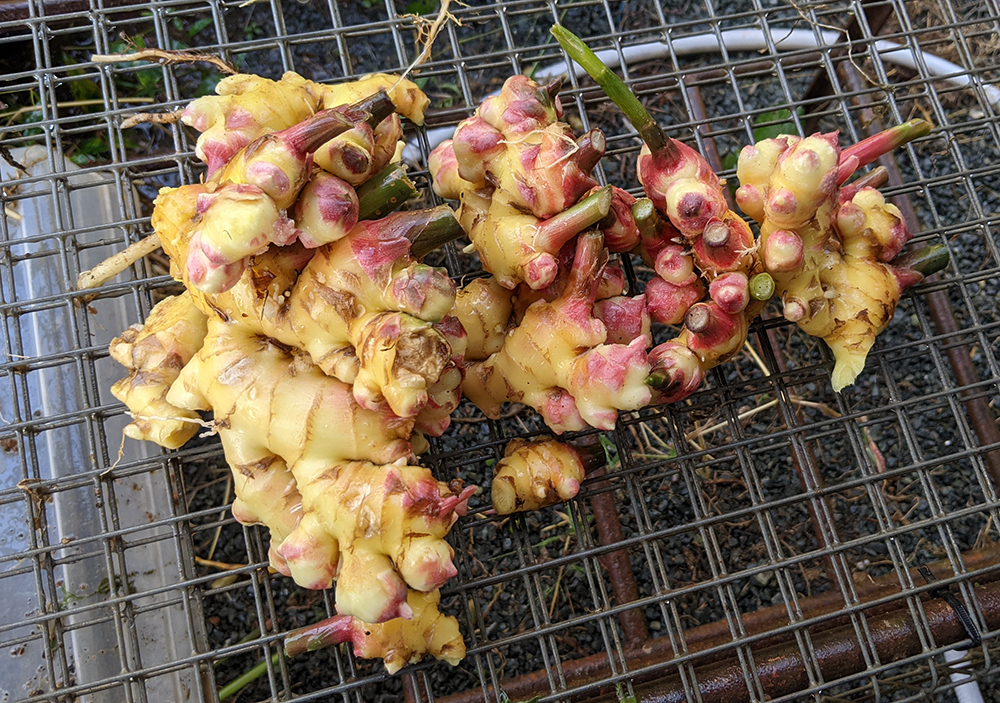
Trimmed and washed baby ginger! Photo by Debbie Roos.
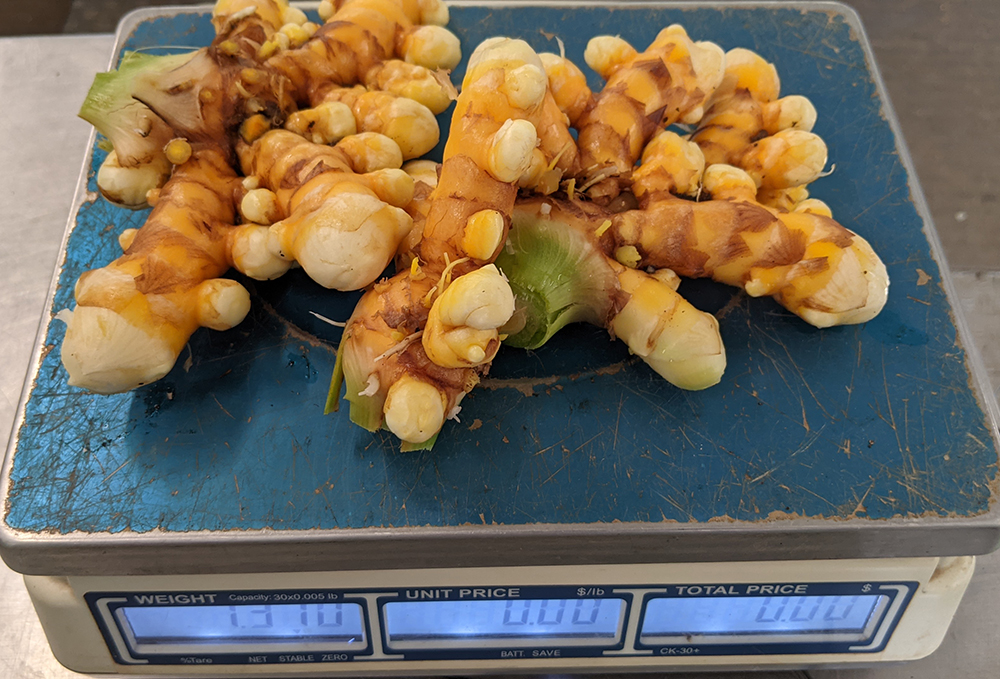
The harvest is weighed and recorded. Photo by Debbie Roos.
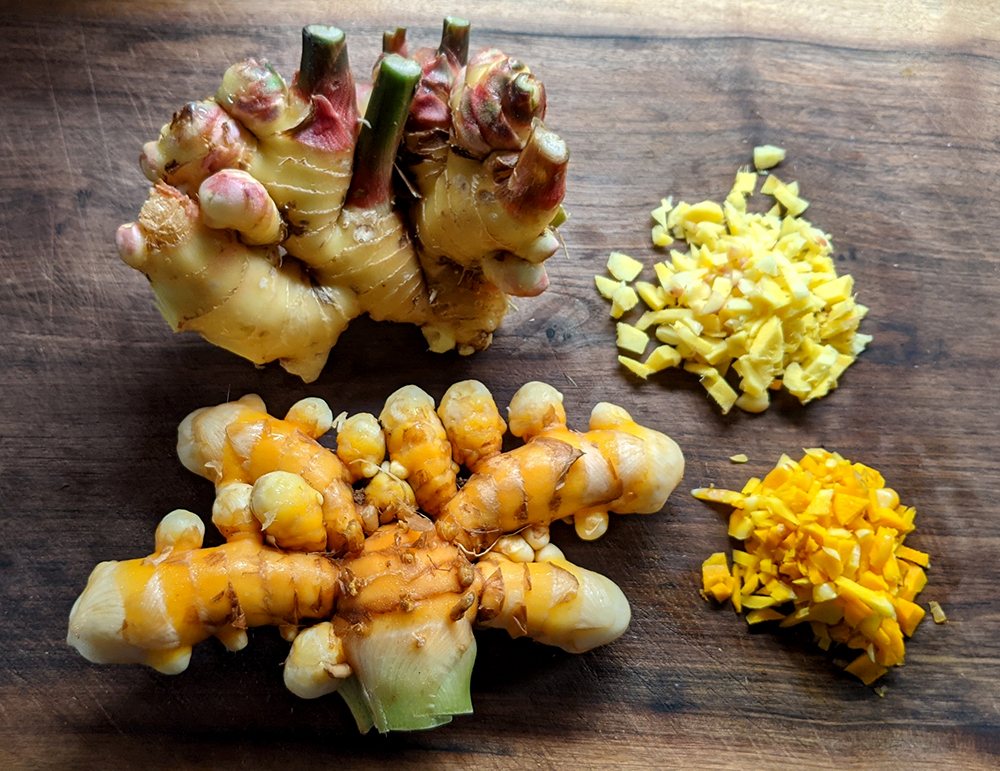
I love cooking with fresh ginger and turmeric! I used this in a tasty chicken soup. Both ginger and turmeric freeze well. Photo by Debbie Roos.


